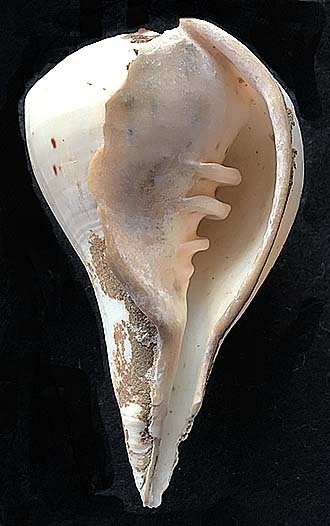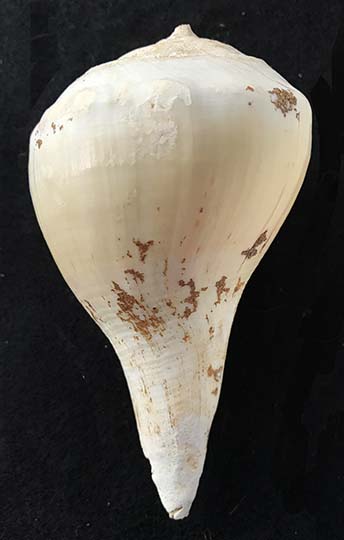The name “chank” is derived from the Indian word “shanka,” meaning the divine-conch shell.
These seashells are very heavy, thick-walled shells made by shallow-marine gastropods (snails) living in tropical waters in India (especially in the Bay of Bengal) and in Sri Lanka. The gastropods are known scientifically by the name Turbinella pyrum Linnaeus, 1758, which is classified in family Turbinellidae.
Most specimens of T. pyrum are of a right-handed (dextrally) coiled shell, like the one shown below. The aperture (where the animal can crawl in and out of its shell) is on the right side as viewed in the image here. Notice the four columellar plicae (folds or “teeth”) on one side of the aperture. Two of them are large, the next one is about half as big, and the fourth one is quite small. These plicae provide places where the animal can grip onto, in order to hold onto its shell, as well as to prevent being pulled out of its shell by a predator. This specimen is 12 cm (4.5 in.) high and 6.5 cm (2.5 in.) wide.
There are left-handed (sinistrially) coiled shells of this gastropod, but they are rare and considered to be sacred. They are particularly highly valued in terms of religious significance in both Hinduism and Buddhism. These particular shells are commonly referred to as “divine conchs” and are often carved, decorated (in gold, semiprecious stones, or metals), and placed in altars. Sometimes, a small hole is drilled at the top of the shell and special attachments are made to allow a high priest to use the shell as a trumpet for ceremonial purposes. See my recent post dealing with subject of "trumpet shells" (of which there are several common ones).
For other interesting details about the Indian chank, see:
Hornell, J. 1914. The sacred chank of India: a monograph on the Indian conch Turbinella pyrum. Madras Fishing Bureau Bulletin 7, 181 pp. Available as a free downloadable pdf from biodiversitylibrary.com


No comments:
Post a Comment